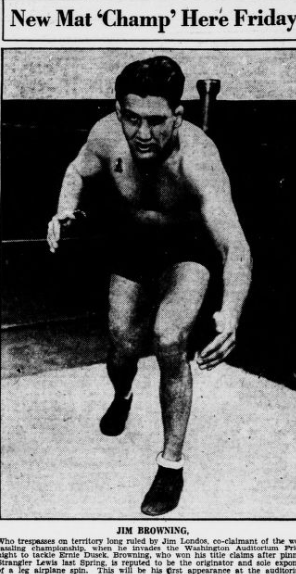Jim Browning hnub qub nyob hometown
Verona, Missouri yog ib lub zos me me nyob rau sab qab zog Missouri. Tsis txhob tshaj 900 Cov neeg nyob hauv nws keeb kwm, Xwb 438 Los yog li ntawd, cov neeg hu ua Verona tsev nyob rau hauv 1926. Tsis tau, Ib tug kev wrestling card yog nyob rau hauv lub nroog rau hnub Zwj Hli, Lub peb hlis ntuj 22, 1926.
Tsis muaj ntau lub tsheb automobiles los yog txoj kev ua tau los kov lawv, yuav nyuaj heev nyob rau hauv 1926. Assuming you could only draw wrestling fans from Lawrence County, where Verona was located, the promoter had a pool of 24,000 fans to draw from.

Photo of Jim Browning in a wrestling pose from the Library of Congress (Public sau)
The card was a success though as the Springfield News-Leader described a large crowd attending the matches. Jim Browning, a future world wrestling champion, was the main reason for the success of the card.
Browning was born in an unincorporated area of Lawrence County, Missouri, known as Verona on March 31, 1903. By the time Browning was in his teens, Verona had been incorporated into a town around 1916.
xim av, who weighed around 215 phaus, developed into a wrestler of some ability. To further his skill set, Browning moved to Emporia, Kansas in 1920 for professional wrestling training.
Browning started professional wrestling in 1923 and secured matches with some of the top wrestlers of the time: Stanislaus Zbyszko, John Pesek and Dick Daviscourt.
In one of his early matches, Browning scored a disqualification victory over former world champion Zbyszko. Promoters obviously saw significant potential in Browning.
Nyob rau hauv 1923, Browning started wrestling for George Hillis, a Springfield, Missouri based promoter, who promoted wrestling matches in southwest Missouri. The arrangement allowed Browning to move back to his hometown.
Nquag, moving to such a small town would be a handicap for a professional wrestling career before widespread airplane travel was available. Since Springfield connected to St. Louis, Missouri by train, Browning was also within reasonable travelling distance to transportation hubs in St. Louis and Kansas City.
On the March 22, 1926 card, Browning was supposed to wrestle frequent world title challenger Dick Daviscourt. Txawm li cas los, Daviscourt was pulled from the card to wrestle current world title claimant Joe Stecher nyob New York City.
Fans still turned out to see Browning wrestle lesser-known Jake Yonsko. Browning made Yonsko look good by dropping the first fall to Yonsko in 7 feeb, 10 vib nas this. Yonsko secured the pin of Browning with a headlock.
Yonsko didn’t get any more offense after the first fall. Browning used a crotch hold to pin Yonsko in only four minutes to end the second fall. The third fall was even shorter. Browning pinned Yonsko in 1 feeb, 10 seconds with a headlock and arm scissors.
The undercard was two matches featuring local wrestlers. Browning was the only significant name on the card but the crowd left the venue pleased with the night’s action.
Verona, Missouri was an odd location for a professional wrestling card but if you had good wrestler people wanted to see, you could successfully promote professional wrestling in smaller towns and venues. Without a star people wanted to support, you were risking a financial disaster.
Koj yuav tawm ib saib los nug cov lus nug txog qhov no los yog tej tsev xa rau kuv Facebook phab.
Qhov chaw: The Springfield Leader and Press, Kaum ib hlis 7, 1923 ib tsab, p. 14 thiab The Springfield News-Leader, Hlis ntuj nqeg 18, 1923 ib tsab, p. 5 thiab lub peb hlis ntuj 24, 1926 ib tsab, p. 5

